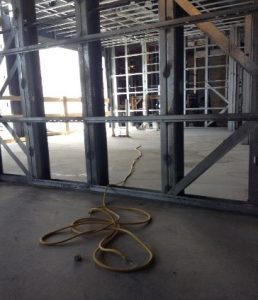Tech Bulletin: Extension Cord Safety
Extension Cords
Mr. Mustard, in the library with an exten sion cord. Yep, an extension cord can kill and cause destruction. Exposed wiring. Missing ground prongs. Bad placement. Daisy chaining. Take your pick – all are common mistakes when it comes to using extension cords.
sion cord. Yep, an extension cord can kill and cause destruction. Exposed wiring. Missing ground prongs. Bad placement. Daisy chaining. Take your pick – all are common mistakes when it comes to using extension cords.
What could be wrong with an extension cord?
Unlike fine wine, extension cords are not better with age. The older the cord, the more exposure to damaging situations, and even the young ones get exposed. When the jacketing is damaged, employees are exposed to live electricity- not a good situation. The OSHA regulation 1926.405(a)(2)(ii)(I) states, “Flexible cords and cables shall be protected from damage. Sharp corners and projections shall be avoided. Flexible cords and cables may pass through doorways or other pinch points, if protection is provided to avoid damage.” Setting a piece of wood under a cord that goes over steel or using a door jamb to leave the door open are just two simple ways to protect your cords. Not only will the  cord thank you, but OSHA will too!
cord thank you, but OSHA will too!
Missing ground prongs and exposed wiring can result in electrocution and can be cited under 1926.334(a)(2)(i) which states “Portable cord and plug connected equipment and flexible cord sets shall be visually inspected before use on any shift for external defects and for evidence of possible internal damage.”
Do the inspections prior to working and don’t use them if they are damaged.
Who needs to know about extension cord safety?
Employees that use them, see them or are around them – so that’s everyone. All employees should be trained on electrical safety including extension cords. Employees use extension cords daily and must know the correct way to use them. And not all cords are acceptable to use for the job. Extension cords are not created equal. A household cord is not rated with the same safety criteria as one used a jobsite. Pick the right tool for the job.
Who can fix extension cords that are damaged?
Qualified electricians that are trained to fix extension cords. This includes:
- Repairing the jacketing
- Replacing the ground prong
- Removing sections of the extension cord
Can I get a recap?
- Exposed wiring, placement of extension cords, daisy chaining, and missing ground prongs can shock or electrocute employees and be cited by OSHA.
- Employees must be trained on electrical hazards in the workplace.
- Only use construction rated extension cords.
- Only trained electricians or qualified employees are permitted to fix damaged cords.
